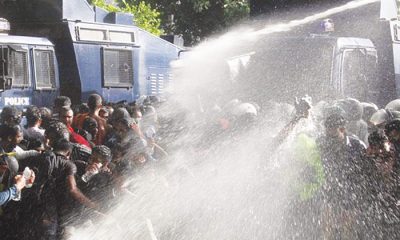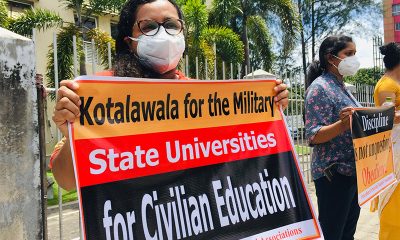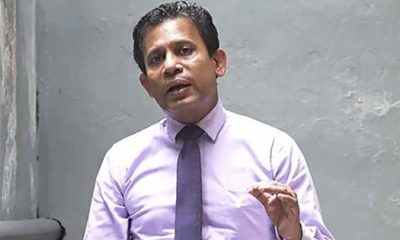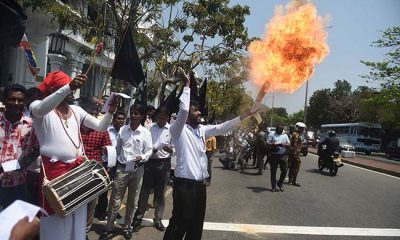Features
The Year of 2022: The Democratic Turn

by Sivamohan Sumathy
“with our bare hands we shape our story”
from, “the dialectic” by sumathy
 The year 2022 draws to a close, a year that has been the hardest and the most glorious of the past 10 years. It has been the year of exploding gas cylinders, the fertiliser ban and women rising against micro finance. It has been the year of long queues. It is when Colombo erupted in protest as millions converged in its centres, and the President fled the country: the year of the Aragalaya and the year of the Poraattam and the Struggle. It is a year of victories, big and small.
The year 2022 draws to a close, a year that has been the hardest and the most glorious of the past 10 years. It has been the year of exploding gas cylinders, the fertiliser ban and women rising against micro finance. It has been the year of long queues. It is when Colombo erupted in protest as millions converged in its centres, and the President fled the country: the year of the Aragalaya and the year of the Poraattam and the Struggle. It is a year of victories, big and small.
Growing disenchantment with the Rajapaksa government’s policy, with its combination of rampant nationalism and rampant neo liberalism, galvanized the people against it at a critical moment, worst economic crisis of our postcolonial history. The protests were popular uprisings, and for a brief moment (at least) they cut across the many social faultlines.
Despite its Colombo and Sinhala centric focus, the protests were a truly mobilizational force. They were potentially mobilizing toward a national popular of a democracy movement, what Gramsci would have called, the National Popular – the coming together of large collectives of people – in a historic conjuncture of forces in a birth of a revolutionary moment. This fragile revolutionary moment, the protests, has been popularly dubbed the Aragalaya. Underlining this promise of a coming together, and in a spirit of celebration and anticipation of the truly mobilizational force of a national popular, I rebaptize the moment, the protests, and the democracy movement, Aragalaya-Poraattam-Struggle.
And the new year begins with ill tidings.
The year is quickly closing in on us. As the dust settles on the Aragalaya and the people are faced with the twin burden of economic hardship and increased repression in the aftermath, we can only become aware of how fleeting the moment of protest has been. We are, alas, only too aware of the many defeats. Time and again, in this column and elsewhere, members of the Kuppi Collective outlined the major setbacks the economy is facing today and the progressive depletion of welfare measures. The Ranil Wickremesinghe budget of 2023 is seen by many, including this writer, as both a sop to the IMF and a fairy tale. It proposes widespread cuts to public spending in education, health, and offers little relief to the already suffering people. The proposal to privatise Telecom and CEB is an ominous sign of what to expect in the future. The retreat of the state from the important responsibility of ensuring the well-being of the people underlines the government’s economic policy.
We are at the cusp of change. But we are the fashioners of change, too. As Stuart Hall says the historical conjuncture has to be seized upon. This is the moment for us to create multiple moments of democratic action severally; holding them all together in a political and theoretical analysis; reflect on and refashion the relations between a) state and society b) state and the individual subject c) the state and the economy and d) the economy and the people.
FUTA and the Aragalaya-Porattam-Struggle
The year 2022 marks the 10th anniversary of the FUTA’s historic trade union action of a hundred days, on the slogan of “6% GDP” and “Save State Education.” These rallying cries struck a sympathetic chord among the people, who had been long suffering under the deteriorating conditions of secondary and tertiary education. “Our Universities Are Under Attack!” said FUTA and called out to the people to support them. In the dark early post war days, FUTA’s action represented a pro-democracy movement, and became a catalyst for the campaign to oust the Rajapaksa regime in the years after. While one may quarrel over the authenticity of the democratic content of the Yahapalana government, and over whether we fought for change in vain or not, it is my considered view that the years of campaign and the movement for change and good governance not only represented a pro-democracy movement, but also opened up spaces for democratic action in the years to come.
Come 2022, 10 years after the 100–day struggle of FUTA. When the protests broke out in April 2022, it caught many people off guard. The University itself was a little slow to react, but it did seize the moment, and respond. Throwing their weight behind the protests, it joined the people in the streets. On June 12, 2022, it launched its proposals for economic and political recovery. However, unlike that decisive moment in 2012, FUTA was not able to offer any form of leadership to the Aragalaya-Porattam-Struggle. The pro-democracy movement was larger than anything FUTA had envisioned so far, for it embraced the concerns of the general public in its multiplicity and in open revolt in a way that FUTA, or its middle-class academics, never prepared for.
Just this week, FUTA and its “sister” unions observed a one-day token strike against increased taxation on their income, under the newly introduced progressive taxation scheme that the government has proposed. This same week, PAFTA, my own union, at Peradeniya Arts, observed an angry three-day boycott of duties, following student violence perpetrated upon a member of our staff and his family. The Union called on all parties to commit to a violence free campus. One may need to hold both these actions together to ponder the varied paths of action of FUTA and the Academic Community. On the one hand, FUTA’s action to protest the taxation policy may seem a highly conservative one, one that smacks of privilege and self-preservation, indifferent to the suffering of the general public; a far cry from the “one million signature campaign” of 2012, demanding 6% GDP for education, Of course the taxation policy is flawed. It lets the very rich off the hook, by capping progressive taxation at 36%, and making raw income the baseline. It also has to be noted that much of the tax revenue of the state comes from indirect, not direct taxes.
On the other hand, the action taken by PAFTA, to confront student violence on campus, is one of those rare occasions where the academic community has turned the lens of critique upon itself and condemned any incidence of violence on campus unequivocally. Student on student violence is a part of a larger and more general scene of undemocratic practices in the university. PAFTA has to be congratulated on the brave stance it has taken. On the other hand, state repression targets university students mercilessly. The state is on a spree of arresting protesting and non-protesting students and others, at will, clamping down on dissent. The Prevention of Terrorism Act continues to target minorities. The campaign for democracy is multiple and at times faces contrary directions.
The cause of free education, and the cause of Save State Education are lost in the muddle of all these competing claims on our attention and allegiances. FUTA and the academic community can play a significant role in this critical time, if it understands this complexity and works out a programme for democracy within it and against it. Given the relative political autonomy and relative independence from corporate structures the academic community enjoys as a social bloc, FUTA can once again perform a vital role in the pro-democracy movement. It will then remain relevant not just to people’s needs but to its own self.
Toward a Democratic Future
Facing privatization in its many insidious forms, the universities are under attack, again. The budget allocation for education for 2023 is roughly 1% of the GDP. Further, this government is accelerating neo liberalization of public education, commenced by previous governments. Privatisation is happening within the university system and is not just imposed from outside. With allocations hardly sufficient to keep our institutions running, universities are compelled to find their own funds. By default, the academic community becomes complicit in privatizing policies, happening mostly in the name of fee levying study programmes, PPP and Quality Assurance Frameworks. Taking a step back, we should explore our own identities and fraught identifications with the forces battering down on the ramparts of the state system.
In this collective mode of action and reflection, FUTA, and the academic community can join forces with those of the larger movement for democracy, in creating a moment of and for the national popular – the conjuncture. In doing so, we may reset the terms of the relations between state, society, subject on the one hand and the economy, people, and the state on the other. Can we do it again, the Aragalaya-Porattam-Struggle?
(Kuppi is a politics and a pedagogy happening on the margins of the lecture hall that parodies, subverts and simultaneously reaffirms social hierarchies.)
Sivamohan Sumathy is attached to the Dept. of English, University of Peradeniya
Features
The heart-friendly health minister

by Dr Gotabhya Ranasinghe
Senior Consultant Cardiologist
National Hospital Sri Lanka
When we sought a meeting with Hon Dr. Ramesh Pathirana, Minister of Health, he graciously cleared his busy schedule to accommodate us. Renowned for his attentive listening and deep understanding, Minister Pathirana is dedicated to advancing the health sector. His openness and transparency exemplify the qualities of an exemplary politician and minister.
Dr. Palitha Mahipala, the current Health Secretary, demonstrates both commendable enthusiasm and unwavering support. This combination of attributes makes him a highly compatible colleague for the esteemed Minister of Health.
Our discussion centered on a project that has been in the works for the past 30 years, one that no other minister had managed to advance.
Minister Pathirana, however, recognized the project’s significance and its potential to revolutionize care for heart patients.
The project involves the construction of a state-of-the-art facility at the premises of the National Hospital Colombo. The project’s location within the premises of the National Hospital underscores its importance and relevance to the healthcare infrastructure of the nation.
This facility will include a cardiology building and a tertiary care center, equipped with the latest technology to handle and treat all types of heart-related conditions and surgeries.
Securing funding was a major milestone for this initiative. Minister Pathirana successfully obtained approval for a $40 billion loan from the Asian Development Bank. With the funding in place, the foundation stone is scheduled to be laid in September this year, and construction will begin in January 2025.
This project guarantees a consistent and uninterrupted supply of stents and related medications for heart patients. As a result, patients will have timely access to essential medical supplies during their treatment and recovery. By securing these critical resources, the project aims to enhance patient outcomes, minimize treatment delays, and maintain the highest standards of cardiac care.
Upon its fruition, this monumental building will serve as a beacon of hope and healing, symbolizing the unwavering dedication to improving patient outcomes and fostering a healthier society.We anticipate a future marked by significant progress and positive outcomes in Sri Lanka’s cardiovascular treatment landscape within the foreseeable timeframe.
Features
A LOVING TRIBUTE TO JESUIT FR. ALOYSIUS PIERIS ON HIS 90th BIRTHDAY

by Fr. Emmanuel Fernando, OMI
Jesuit Fr. Aloysius Pieris (affectionately called Fr. Aloy) celebrated his 90th birthday on April 9, 2024 and I, as the editor of our Oblate Journal, THE MISSIONARY OBLATE had gone to press by that time. Immediately I decided to publish an article, appreciating the untiring selfless services he continues to offer for inter-Faith dialogue, the renewal of the Catholic Church, his concern for the poor and the suffering Sri Lankan masses and to me, the present writer.
It was in 1988, when I was appointed Director of the Oblate Scholastics at Ampitiya by the then Oblate Provincial Fr. Anselm Silva, that I came to know Fr. Aloy more closely. Knowing well his expertise in matters spiritual, theological, Indological and pastoral, and with the collaborative spirit of my companion-formators, our Oblate Scholastics were sent to Tulana, the Research and Encounter Centre, Kelaniya, of which he is the Founder-Director, for ‘exposure-programmes’ on matters spiritual, biblical, theological and pastoral. Some of these dimensions according to my view and that of my companion-formators, were not available at the National Seminary, Ampitiya.
Ever since that time, our Oblate formators/ accompaniers at the Oblate Scholasticate, Ampitiya , have continued to send our Oblate Scholastics to Tulana Centre for deepening their insights and convictions regarding matters needed to serve the people in today’s context. Fr. Aloy also had tried very enthusiastically with the Oblate team headed by Frs. Oswald Firth and Clement Waidyasekara to begin a Theologate, directed by the Religious Congregations in Sri Lanka, for the contextual formation/ accompaniment of their members. It should very well be a desired goal of the Leaders / Provincials of the Religious Congregations.
Besides being a formator/accompanier at the Oblate Scholasticate, I was entrusted also with the task of editing and publishing our Oblate journal, ‘The Missionary Oblate’. To maintain the quality of the journal I continue to depend on Fr. Aloy for his thought-provoking and stimulating articles on Biblical Spirituality, Biblical Theology and Ecclesiology. I am very grateful to him for his generous assistance. Of late, his writings on renewal of the Church, initiated by Pope St. John XX111 and continued by Pope Francis through the Synodal path, published in our Oblate journal, enable our readers to focus their attention also on the needed renewal in the Catholic Church in Sri Lanka. Fr. Aloy appreciated very much the Synodal path adopted by the Jesuit Pope Francis for the renewal of the Church, rooted very much on prayerful discernment. In my Religious and presbyteral life, Fr.Aloy continues to be my spiritual animator / guide and ongoing formator / acccompanier.
Fr. Aloysius Pieris, BA Hons (Lond), LPh (SHC, India), STL (PFT, Naples), PhD (SLU/VC), ThD (Tilburg), D.Ltt (KU), has been one of the eminent Asian theologians well recognized internationally and one who has lectured and held visiting chairs in many universities both in the West and in the East. Many members of Religious Congregations from Asian countries have benefited from his lectures and guidance in the East Asian Pastoral Institute (EAPI) in Manila, Philippines. He had been a Theologian consulted by the Federation of Asian Bishops’ Conferences for many years. During his professorship at the Gregorian University in Rome, he was called to be a member of a special group of advisers on other religions consulted by Pope Paul VI.
Fr. Aloy is the author of more than 30 books and well over 500 Research Papers. Some of his books and articles have been translated and published in several countries. Among those books, one can find the following: 1) The Genesis of an Asian Theology of Liberation (An Autobiographical Excursus on the Art of Theologising in Asia, 2) An Asian Theology of Liberation, 3) Providential Timeliness of Vatican 11 (a long-overdue halt to a scandalous millennium, 4) Give Vatican 11 a chance, 5) Leadership in the Church, 6) Relishing our faith in working for justice (Themes for study and discussion), 7) A Message meant mainly, not exclusively for Jesuits (Background information necessary for helping Francis renew the Church), 8) Lent in Lanka (Reflections and Resolutions, 9) Love meets wisdom (A Christian Experience of Buddhism, 10) Fire and Water 11) God’s Reign for God’s poor, 12) Our Unhiddden Agenda (How we Jesuits work, pray and form our men). He is also the Editor of two journals, Vagdevi, Journal of Religious Reflection and Dialogue, New Series.
Fr. Aloy has a BA in Pali and Sanskrit from the University of London and a Ph.D in Buddhist Philosophy from the University of Sri Lankan, Vidyodaya Campus. On Nov. 23, 2019, he was awarded the prestigious honorary Doctorate of Literature (D.Litt) by the Chancellor of the University of Kelaniya, the Most Venerable Welamitiyawe Dharmakirthi Sri Kusala Dhamma Thera.
Fr. Aloy continues to be a promoter of Gospel values and virtues. Justice as a constitutive dimension of love and social concern for the downtrodden masses are very much noted in his life and work. He had very much appreciated the commitment of the late Fr. Joseph (Joe) Fernando, the National Director of the Social and Economic Centre (SEDEC) for the poor.
In Sri Lanka, a few religious Congregations – the Good Shepherd Sisters, the Christian Brothers, the Marist Brothers and the Oblates – have invited him to animate their members especially during their Provincial Congresses, Chapters and International Conferences. The mainline Christian Churches also have sought his advice and followed his seminars. I, for one, regret very much, that the Sri Lankan authorities of the Catholic Church –today’s Hierarchy—- have not sought Fr.
Aloy’s expertise for the renewal of the Catholic Church in Sri Lanka and thus have not benefited from the immense store of wisdom and insight that he can offer to our local Church while the Sri Lankan bishops who governed the Catholic church in the immediate aftermath of the Second Vatican Council (Edmund Fernando OMI, Anthony de Saram, Leo Nanayakkara OSB, Frank Marcus Fernando, Paul Perera,) visited him and consulted him on many matters. Among the Tamil Bishops, Bishop Rayappu Joseph was keeping close contact with him and Bishop J. Deogupillai hosted him and his team visiting him after the horrible Black July massacre of Tamils.
Features
A fairy tale, success or debacle

Sri Lanka-Singapore Free Trade Agreement
By Gomi Senadhira
senadhiragomi@gmail.com
“You might tell fairy tales, but the progress of a country cannot be achieved through such narratives. A country cannot be developed by making false promises. The country moved backward because of the electoral promises made by political parties throughout time. We have witnessed that the ultimate result of this is the country becoming bankrupt. Unfortunately, many segments of the population have not come to realize this yet.” – President Ranil Wickremesinghe, 2024 Budget speech
Any Sri Lankan would agree with the above words of President Wickremesinghe on the false promises our politicians and officials make and the fairy tales they narrate which bankrupted this country. So, to understand this, let’s look at one such fairy tale with lots of false promises; Ranil Wickremesinghe’s greatest achievement in the area of international trade and investment promotion during the Yahapalana period, Sri Lanka-Singapore Free Trade Agreement (SLSFTA).
It is appropriate and timely to do it now as Finance Minister Wickremesinghe has just presented to parliament a bill on the National Policy on Economic Transformation which includes the establishment of an Office for International Trade and the Sri Lanka Institute of Economics and International Trade.
Was SLSFTA a “Cleverly negotiated Free Trade Agreement” as stated by the (former) Minister of Development Strategies and International Trade Malik Samarawickrama during the Parliamentary Debate on the SLSFTA in July 2018, or a colossal blunder covered up with lies, false promises, and fairy tales? After SLSFTA was signed there were a number of fairy tales published on this agreement by the Ministry of Development Strategies and International, Institute of Policy Studies, and others.
However, for this article, I would like to limit my comments to the speech by Minister Samarawickrama during the Parliamentary Debate, and the two most important areas in the agreement which were covered up with lies, fairy tales, and false promises, namely: revenue loss for Sri Lanka and Investment from Singapore. On the other important area, “Waste products dumping” I do not want to comment here as I have written extensively on the issue.
1. The revenue loss
During the Parliamentary Debate in July 2018, Minister Samarawickrama stated “…. let me reiterate that this FTA with Singapore has been very cleverly negotiated by us…. The liberalisation programme under this FTA has been carefully designed to have the least impact on domestic industry and revenue collection. We have included all revenue sensitive items in the negative list of items which will not be subject to removal of tariff. Therefore, 97.8% revenue from Customs duty is protected. Our tariff liberalisation will take place over a period of 12-15 years! In fact, the revenue earned through tariffs on goods imported from Singapore last year was Rs. 35 billion.
The revenue loss for over the next 15 years due to the FTA is only Rs. 733 million– which when annualised, on average, is just Rs. 51 million. That is just 0.14% per year! So anyone who claims the Singapore FTA causes revenue loss to the Government cannot do basic arithmetic! Mr. Speaker, in conclusion, I call on my fellow members of this House – don’t mislead the public with baseless criticism that is not grounded in facts. Don’t look at petty politics and use these issues for your own political survival.”
I was surprised to read the minister’s speech because an article published in January 2018 in “The Straits Times“, based on information released by the Singaporean Negotiators stated, “…. With the FTA, tariff savings for Singapore exports are estimated to hit $10 million annually“.
As the annual tariff savings (that is the revenue loss for Sri Lanka) calculated by the Singaporean Negotiators, Singaporean $ 10 million (Sri Lankan rupees 1,200 million in 2018) was way above the rupees’ 733 million revenue loss for 15 years estimated by the Sri Lankan negotiators, it was clear to any observer that one of the parties to the agreement had not done the basic arithmetic!
Six years later, according to a report published by “The Morning” newspaper, speaking at the Committee on Public Finance (COPF) on 7th May 2024, Mr Samarawickrama’s chief trade negotiator K.J. Weerasinghehad had admitted “…. that forecasted revenue loss for the Government of Sri Lanka through the Singapore FTA is Rs. 450 million in 2023 and Rs. 1.3 billion in 2024.”
If these numbers are correct, as tariff liberalisation under the SLSFTA has just started, we will pass Rs 2 billion very soon. Then, the question is how Sri Lanka’s trade negotiators made such a colossal blunder. Didn’t they do their basic arithmetic? If they didn’t know how to do basic arithmetic they should have at least done their basic readings. For example, the headline of the article published in The Straits Times in January 2018 was “Singapore, Sri Lanka sign FTA, annual savings of $10m expected”.
Anyway, as Sri Lanka’s chief negotiator reiterated at the COPF meeting that “…. since 99% of the tariffs in Singapore have zero rates of duty, Sri Lanka has agreed on 80% tariff liberalisation over a period of 15 years while expecting Singapore investments to address the imbalance in trade,” let’s turn towards investment.
Investment from Singapore
In July 2018, speaking during the Parliamentary Debate on the FTA this is what Minister Malik Samarawickrama stated on investment from Singapore, “Already, thanks to this FTA, in just the past two-and-a-half months since the agreement came into effect we have received a proposal from Singapore for investment amounting to $ 14.8 billion in an oil refinery for export of petroleum products. In addition, we have proposals for a steel manufacturing plant for exports ($ 1 billion investment), flour milling plant ($ 50 million), sugar refinery ($ 200 million). This adds up to more than $ 16.05 billion in the pipeline on these projects alone.
And all of these projects will create thousands of more jobs for our people. In principle approval has already been granted by the BOI and the investors are awaiting the release of land the environmental approvals to commence the project.
I request the Opposition and those with vested interests to change their narrow-minded thinking and join us to develop our country. We must always look at what is best for the whole community, not just the few who may oppose. We owe it to our people to courageously take decisions that will change their lives for the better.”
According to the media report I quoted earlier, speaking at the Committee on Public Finance (COPF) Chief Negotiator Weerasinghe has admitted that Sri Lanka was not happy with overall Singapore investments that have come in the past few years in return for the trade liberalisation under the Singapore-Sri Lanka Free Trade Agreement. He has added that between 2021 and 2023 the total investment from Singapore had been around $162 million!
What happened to those projects worth $16 billion negotiated, thanks to the SLSFTA, in just the two-and-a-half months after the agreement came into effect and approved by the BOI? I do not know about the steel manufacturing plant for exports ($ 1 billion investment), flour milling plant ($ 50 million) and sugar refinery ($ 200 million).
However, story of the multibillion-dollar investment in the Petroleum Refinery unfolded in a manner that would qualify it as the best fairy tale with false promises presented by our politicians and the officials, prior to 2019 elections.
Though many Sri Lankans got to know, through the media which repeatedly highlighted a plethora of issues surrounding the project and the questionable credentials of the Singaporean investor, the construction work on the Mirrijiwela Oil Refinery along with the cement factory began on the24th of March 2019 with a bang and Minister Ranil Wickremesinghe and his ministers along with the foreign and local dignitaries laid the foundation stones.
That was few months before the 2019 Presidential elections. Inaugurating the construction work Prime Minister Ranil Wickremesinghe said the projects will create thousands of job opportunities in the area and surrounding districts.
The oil refinery, which was to be built over 200 acres of land, with the capacity to refine 200,000 barrels of crude oil per day, was to generate US$7 billion of exports and create 1,500 direct and 3,000 indirect jobs. The construction of the refinery was to be completed in 44 months. Four years later, in August 2023 the Cabinet of Ministers approved the proposal presented by President Ranil Wickremesinghe to cancel the agreement with the investors of the refinery as the project has not been implemented! Can they explain to the country how much money was wasted to produce that fairy tale?
It is obvious that the President, ministers, and officials had made huge blunders and had deliberately misled the public and the parliament on the revenue loss and potential investment from SLSFTA with fairy tales and false promises.
As the president himself said, a country cannot be developed by making false promises or with fairy tales and these false promises and fairy tales had bankrupted the country. “Unfortunately, many segments of the population have not come to realize this yet”.
(The writer, a specialist and an activist on trade and development issues . )
























